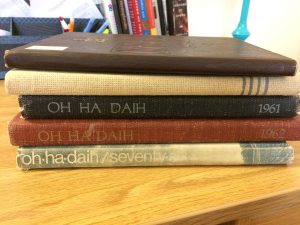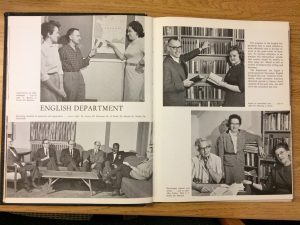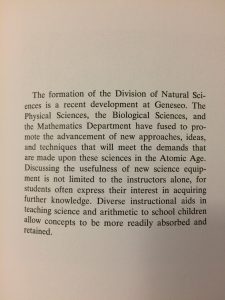This week I’ve been looking at yearbooks from years that I feel are most relevant to changes in Geneseo’s curriculum and higher education in general, as determined by my previous research. I’ve started with the yearbooks from 1949, ’51, ’61, ’62, and ’76. These are years that, respectively, were affected by the GI Bill and the end of World War II and then the transition to a liberal arts curriculum were made, and, by ’76, in fuller effect. Since most of these changes were gradual and not fully felt in a single academic year, I may go back and look at other yearbooks from the same time periods at another time.

1949, ’51, ’61, ’62,and ’76 editions of Oh Ha Daih–the name adopted after Geneseo became a state teachers college recognizes regional Native Americans (Mahood, 130)
My current interest is the curriculum, and, perhaps unsurprisingly, this was not a major focal point in any of these yearbooks. While not unacknowledged, the curriculum is primarily noted in the pictures of the faculty, divided by department.

The English Department’s pages in the 1961 Oh Ha Daih (40-41)
The pictures are accompanied by short blurbs about each department, and while some include changes made to the specific curriculum of the department, such as English in ’61, it is difficult to discern any changes made to the college’s curriculum as a whole. While I didn’t read every book cover to cover, I didn’t even find a mention of any form of a liberal arts curriculum in the ’61, ’62, and ’76 yearbooks.

Changes in the English Department noted in the 1961 Oh Ha Daih (41)

This academic reorganization could perhaps be attributed to Geneseo’s transition into a liberal arts college, but no such assertion is made in the yearbook (1972 Oh Ha Daih, 37)
Of course, the point of a yearbook isn’t to provide detailed descriptions of the curriculum, but rather to capture the culture, community, and personalities of the college in that year (likely in a positive and nostalgic sense). Before I approach that aspect of my research, I want to have a firmer grasp on the changes in Geneseo’s curriculum, which I will hopefully have in a greater sense after I visit the archives later this week. While the source I have mainly been using in regards to the curriculum (Mahood’s ) is incredibly helpful and comprehensive, it has its own narrative, and I would like to go through old undergraduate bulletins and other primary sources to create my own narrative for the website. Currently I think that the curriculum will be the most important aspect of my (print-based) research, and I plan to allow my findings in this area to inform how approach the greater college community and culture that the yearbooks are more concerned with.
Beyond my research, I started playing with themes on the website and added a placeholder title and header. I found several themes that I didn’t like and one that works for now (Datar), although since we don’t have anything of any significance up yet, it may need to changed in the future. I do like the theme’s minimalist layout and flexible header, so I will probably look for themes with similar features should the need to change it arise.
I’m expecting my visit to the archives to be the highlight of this coming week in research, and I also hope to move forward in the process of planning and scheduling interviews—pending, of course, on IRB approval.

Leave a Reply